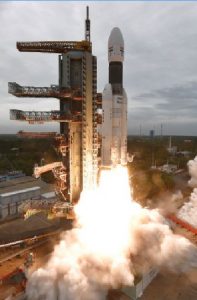 The recently launched Chandrayaan-2 orbiter continues to do path-breaking science, helping us understand the features of the moon in an unprecedented detail. The orbiter, using its Orbiter High Resolution Camera (OHRC), recently sent some high spatial resolution pictures of the moon.
The recently launched Chandrayaan-2 orbiter continues to do path-breaking science, helping us understand the features of the moon in an unprecedented detail. The orbiter, using its Orbiter High Resolution Camera (OHRC), recently sent some high spatial resolution pictures of the moon.
According to the latest updates from the Indian Space Research Organisation (ISRO), the orbiter has also been observing the solar flares emanating from the sun, which will help in furthering understanding of the lunar surface.
The measurement of the X-rays from these solar flares was carried out through one of the eight scientific payloads onboard the orbiter, which is circling the moon above 100 kms from its surface. The spacecraft will utilize the X-rays emitted by the sun in an innovative way to study elements on the lunar surface. The objective is to identify the elements on the lunar surface after studying the behavior of the atoms of elements when hit by solar X-rays.
According to ISRO, Chandrayaan-2 orbiter carries two instruments, Chandrayaan 2 Large Area Soft X-ray Spectrometer (CLASS) and Solar X-ray Monitor (XSM), to measure the lunar elemental composition using this technique. Here, the CLASS payload detects the characteristic lines from the lunar surface and the XSM payload simultaneously measures the solar X-ray spectrum.
Among the orbiter’s main objectives is to study the elements and minerals on the lunar surface, and according to ISRO, the timing of the solar flare was essential for observing this phenomenon. Solar flares are the occasional bursts of radiation which result from the release of magnetic energy by the sunspots. Lasting from minutes to several hours, these are the brightest spots on the surface of the sun. The X-rays emitted by this solar bursts are a good way for the scientists to study the sun and its internal behavior.
The mission: Hit or a miss?
India’s hopes for landing a rover on the moon’s surface onboard the Chandrayaan-2 mission were dashed when, during the descent on the moon’s surface, the space agency lost communication with the Vikram lander. The world watched in awe as India began the controlled descent of the Vikram lander and the Pragyaan rover on September 7. After the successful separation from the orbiter, the lander stopped communicating with the ISRO when it was at a distance of only 2.1 kms from the lunar surface. The observations later confirmed the lander had hard-landed on the surface of the moon, and the images confirmed the lander in a tilted position on the lunar surface.
But can the ISRO chairman, K. Sivan’s comments that the mission achieved 90-95% success be called logical? There have been many refutations of this claim even by the scientists associated with ISRO, given that the orbiter hadn’t even started making observations even when the no fate was known of the lander. The immense hype around Chandrayaan-2 was because of the fact that it represented India’s first attempt at controlled landing on the moon, which would have put on the map of select few countries having achieved such a feat. Moon landing was the essence of this mission. And that objective clearly wasn’t achieved.
It’s not clear if the colossal media hype generated around the mission had forced the ISRO chief to do firefighting and issue such statements. India has already sent a mission to moon, called Chandrayaan-1, in the past, which was more of a technology demonstrator mission. However, the curiosity this time was all about the moon landing. Failures are a part of scientific advancements. There is nothing to be ashamed or demotivated about such mistakes as one happens to always learn from such shortcomings. It’s how our scientific capabilities have grown over the centuries, by employing alternative methods to succeed the next time.
However, the setback isn’t a big deal for ISRO, which has mastered its space mission capabilities over the decades and has been doing better on every new mission. India’s indigenous space capabilities have grown tremendously over the years. Advancing from SLV to GSLV MK III launchers, ISRO has become a globally acknowledged space agency, helping even advanced countries with satellite launches. The Chandrayaan-2 mission setback has not deterred the spirit of the organisation. India is due to launch its first manned mission, called the Gaganyaan, to the near earth orbit by 2022. The agency will need an entirely different infrastructure for the three astronauts who are scheduled to fly in the spacecraft, including the training and creating a sustainable environment inside the craft, which the agency will be attempting for the first time.
Considering the success rate that ISRO has been commanding over the decades, it will not be reasonable to judge the capability of the organisation for a single failure, even when other nations have also failed at their first attempts at moon landing. The prestigious agency continues to work on its other missions, including the Gaganyaan, with full enthusiasm. It has also announced that the next attempt to land on the moon will happen soon and this time it’s going to be a success. The Vikram setback notwithstanding, the Chandrayaan-2 orbiter continues to send phenomenal lunar data back to earth, which will surely help in its future exploration. The lessons learnt in this mission will be used to build a relatively flawless spacecraft system which is bound to succeed the next time. ISRO remains one of the most successful public sector scientific institutions in the country, having carved a niche in the space applications and launch capabilities around the world. And it’s only to going to get better in the years to come.












